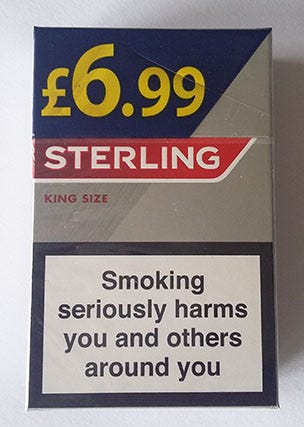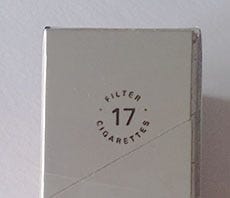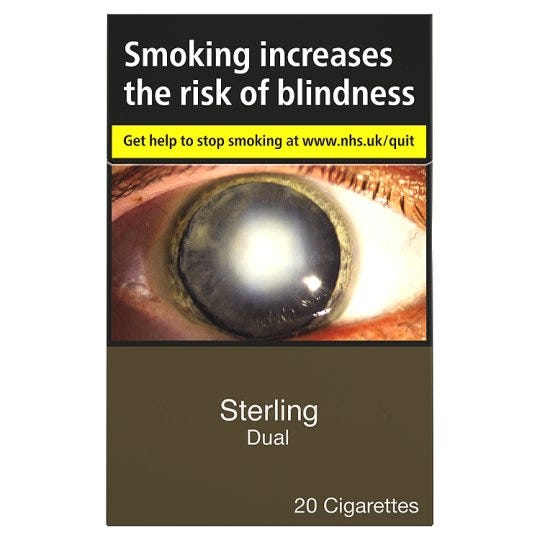Four days until all cigarettes must be in standardised “plain” packaging
If you saw our article yesterday you’ll be aware that the UK is about to wave goodbye to glitzy tobacco packaging forever. This week we’re explaining why this is a big win for public health. Today’s article looks at price-marked packaging. For more on standardised plain packaging, please see this ASH briefing.
Sterling is currently the best-selling cigarette brand in the UK[1] and is manufactured by Japan Tobacco International (JTI). It has achieved this position through a combination of its branding and its marketing techniques, largely focused on price.

The packet shown is labelled as costing £6.99, which is at the lower priced end of the market. However as with so much in the tobacco industry, things are not as straightforward as they appear. Most smokers would assume that a packet contains 20 cigarettes. Not so in this case. Tucked away on the side of the box, hoping to go unnoticed, is the small announcement that this pack only contains 17 cigarettes.

This is a clear example of the many ways in which the tobacco industry misleads consumers, who receive 15% fewer cigarettes than they may reasonably expect. In this way, they keep the perceived cost of their products down, while the consumer is actually paying more without realising it.
The new laws on tobacco packaging mean that JTI and other tobacco companies are no longer able to use such devious tactics to mislead consumers. From Saturday, pack sizes must contain a minimum of 20 cigarettes and price-marked packs will no longer be allowed.
This is important, not just from a consumer standpoint but from a public health perspective. There is a huge amount of evidence showing that price is a key factor in encouraging people to quit smoking. As long ago as 1993 the Conservative government introduced a tax escalator on cigarettes of 3% above inflation as “the most effective way to reduce smoking”, [2] and annual tax increases above inflation are still in place today.
Just this year, The National Cancer Institute (NCI) and World Health Organization (WHO) concluded in their 2017 report, The Economics of Tobacco and Tobacco Control:
“A substantial body of research, which has accumulated over many decades and from many countries, shows that significantly increasing the excise tax and price of tobacco products is the single most consistently effective tool for reducing tobacco use. Significant increases in tobacco taxes and prices reduce tobacco use by leading some current users to quit, preventing potential users from initiating use, and reducing consumption among current users.” [3]
It’s clear from the evidence that if smokers of Sterling cigarettes understood how much more they were paying, they would be more inclined to quit. Price-marked packs are so important to the tobacco industry there have been allegations by a whistle-blower [4] that they continue to put promotional price stickers on packs in contravention of the laws after the deadline of 20 May 2016.

The new regulations are designed to help people stop smoking and to discourage children and young people from becoming addicted. Pricing is an important part of this battle.
References
[1] https://www.statista.com/statistics/292123/top-leading-cigarette-brands-in-the-united-kingdom-uk/
[2] HC Deb 30 November 1993. c939 (budget speech)
[3] U.S. National Cancer Institute & World Health Organization, The Economics of Tobacco and Tobacco Control, National Cancer Institute Tobacco Control Monograph 21, NIH Publication №16-CA-8029A, Bethesda, MD: U.S. Department of Health and Human Services, National Institutes of Health, National Cancer Institute; and Geneva, CH: World Health Organization; 2016, https://cancercontrol.cancer.gov/brp/tcrb/monographs/21/docs/m21_complete.pdf
[4] Doward J. How tobacco firms flout UK law on plain packaging. Observer. 9 April 2017.